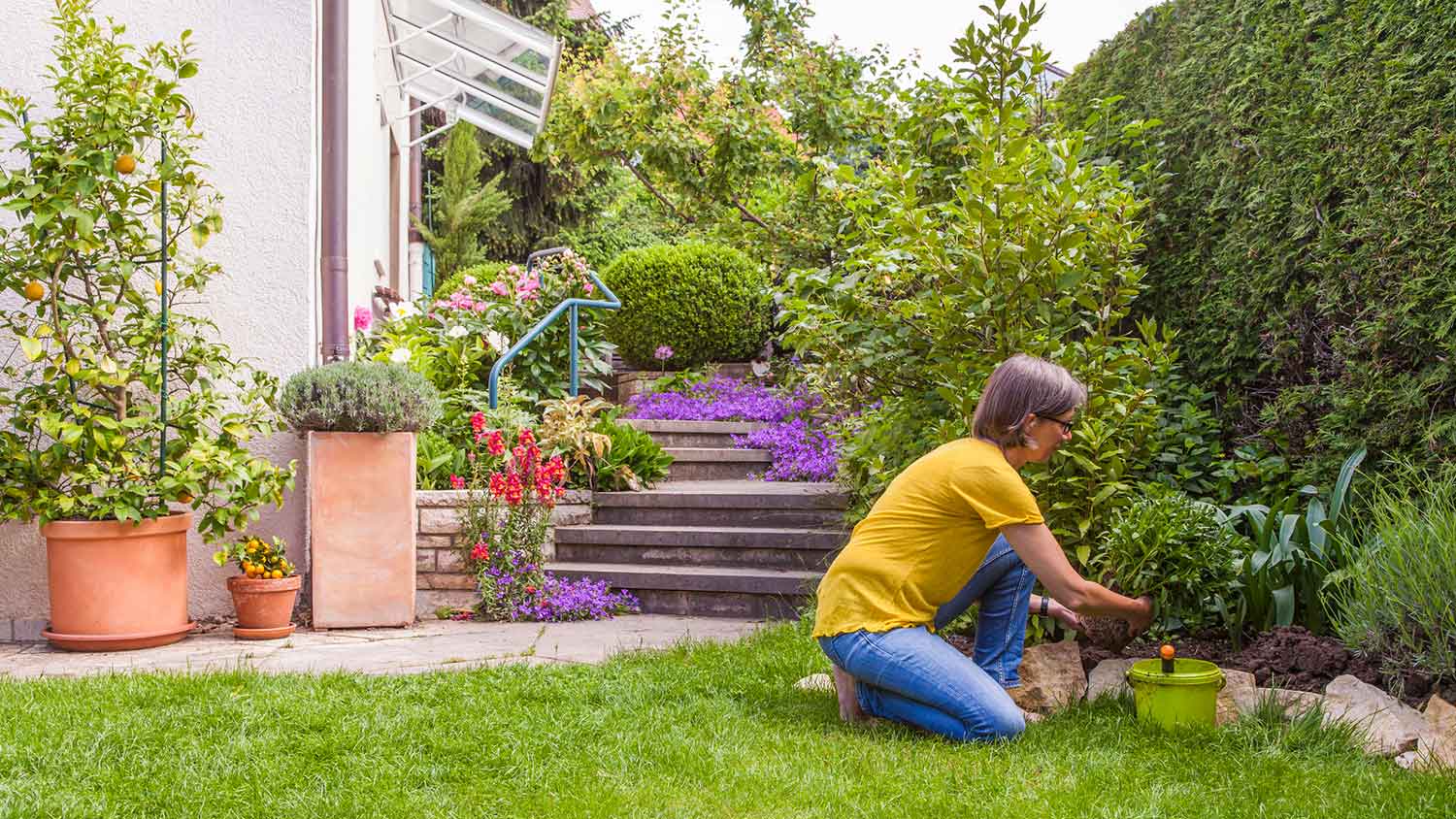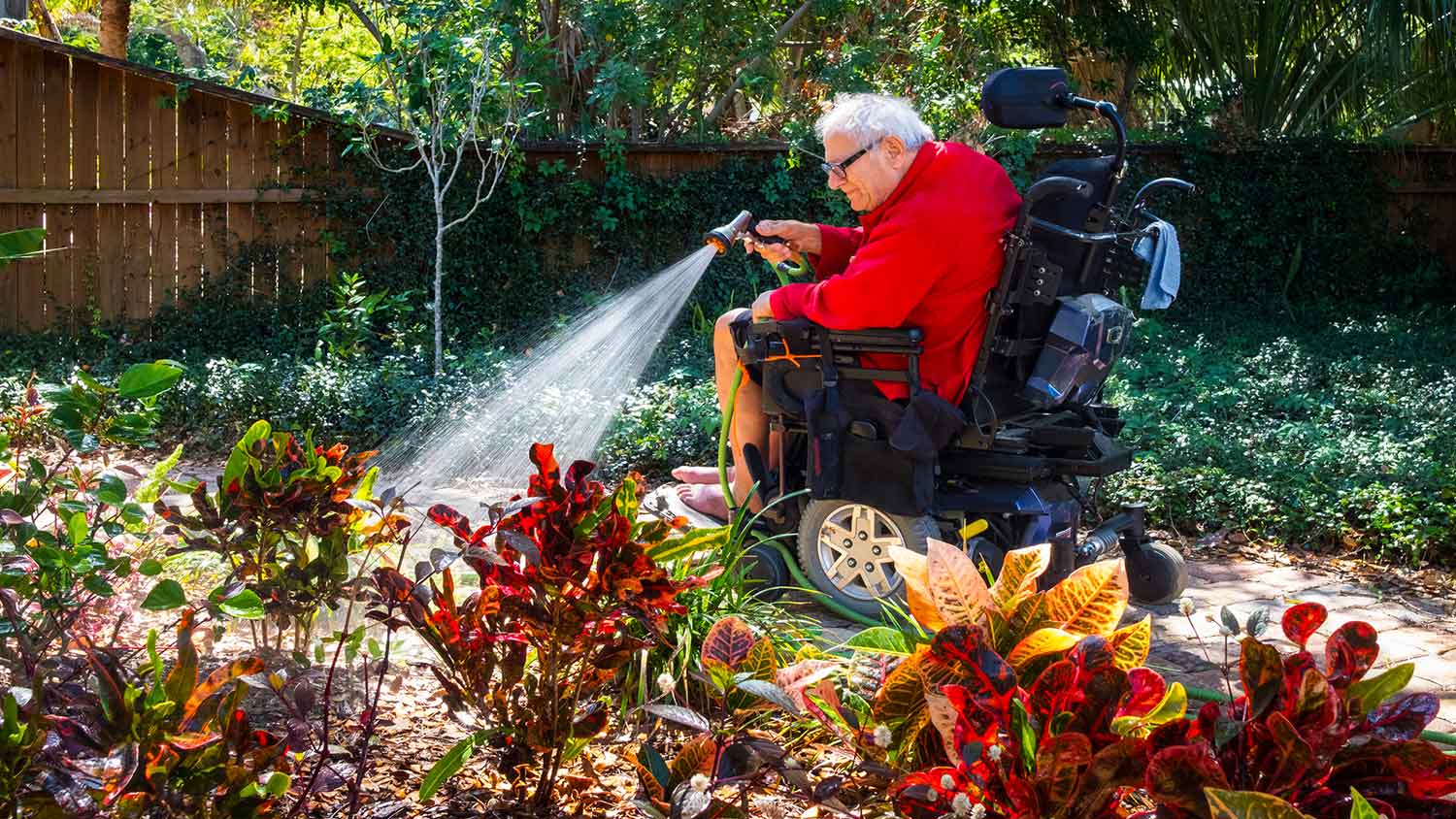10 Common Landscaping Mistakes to Avoid in Your Garden
Here’s the dirt on what not to do in your yard


Gardening is all about experimentation. What works in one yard might not thrive in another. But even the most experienced gardener can sometimes make mistakes. From overplanting to underwatering to ignoring a plant’s gardening zone, these are some of the most common missteps when it comes to landscaping your lot.
1. Planting Too Close Together
You want the most enviable garden on the block, but having a beautiful garden takes patience. Even if you have a big landscaping budget and can purchase larger-sized, mature plants, your plants still need room to grow to look their best.
Note the height and width of the plants you invest in and give them space to grow.
Use annuals to fill in gaps in your garden beds in the meantime. Annuals have shallow roots and won’t impact the growth of most perennials.
2. Forgetting to Check Plant Height
While it’s true you want plants of varying height for visual interest, think about where you put the tallest-growing plants compared to the others. Many plants can appear to be the same size when you bring them home in one-gallon nursery pots, but it doesn’t take long before taller plants start to overshadow.
Walk around your garden bed and view it from different angles before planting.
Plant tall plants toward the middle or highest point of a garden bed, and graduate height size from there.
When planting against a wall or a fence, plant the tallest plants toward the back.
3. Planting for One Season

There’s no arguing that most gardens look pretty glorious in the summer, but fail to think about the other seasons and you’ll go from showy to solid green by August. Stagger your bloom times by adding flowers and perennials that bloom throughout the growing season, from early spring bloomers to showy fall perennials.
4. Ignoring Light Requirements
Plants fall into three main categories of light requirements: full sun; partial sun/partial shade; and shade. Don’t underestimate the importance of the plant’s optimal light conditions. While many plants can survive for a time in the wrong light conditions, they certainly won’t thrive. Not enough light can make plants leggy or prevent blooms. Too much light, and those tender shade plants will burn.
In addition to noting the light requirements of any plant you purchase (almost always on the label or tag from a nursery), it is also wise to think about how the sun moves during different seasons, including if trees or buildings block light.
Try mapping out the basic cardinal directions in your yard to develop a landscaping plan for your garden following these general guidelines:
South-facing beds get the most, all-day sunlight.
East-facing means morning sunlight and is good for partial sun plants.
West-facing means afternoon light, partial sun to full sun, depending on how hot it gets.
North-facing is typically less direct sunlight so shade plants will do better here.
5. Ignoring Your Zone
Here’s a common landscaping mistake to avoid: Before you spend a fortune on your favorite perennials, make sure they can survive winter in your hardiness zone. If you don’t know your zone already, the USDA plant hardiness map will give you the number you’re looking for.
You can still put plants that don't match your zone in your garden; just think of them as annuals as they will likely not survive through the cold snap of the winter.
6. Neglecting the Soil
Plants get their nutrients from the soil, but all dirt is not equal. Depending on where you live, the soil may be sandy, heavy with clay, or even have toxins in it. Before you undertake any major gardening project, test your soil to see what your PH level is.
Generally speaking, you want a PH level between 5 and 7. Amend your soil based on the results.
Acidic soil can balance out with lime.
Alkaline soil can balance out with sulfate.
Amend sandy soil with manure, compost, or leaf mulch.
Amend clay soil with a rich mix that includes some peat, compost, and mulch.
Aerate clay soil regularly to avoid compaction.
7. Overwatering or Underwatering

Incorrect watering is one of the most common problems the average gardener experiences. And just how much water your plants need will depend on seasonal factors, such as rainfall and humidity, along with the plant’s drought tolerance.
The best rule of thumb is to water when the top two inches or so of soil has dried out.
Growing seeds need more frequent watering.
Check your garden beds twice a week to see if the soil is moist enough.
Overwatering happens more frequently than underwatering.
Signs of overwatering in a perennial garden include soggy soil that smells rotten, powdery mildew, rotting stems, drooping plants, and leaf drop.
Signs of underwatering include wilting plants, dry cracked soil, dry leaf edges, flower drop or failure to flower, and curling leaves.
Invest in a drip irrigation system with a timer. It will save you money and avoid killing plants from watering mistakes.
8. Not Grading Your Landscape
From the slope of your lawn to the placement of garden beds near your house, its essential landscape to prevent basement flooding. Keep a gradual slope away from your home’s foundation so that when it rains or you water, the water flows away from your basement, not toward it.
9. Fertilizing Too Much (or Too Little)
The idea that giving a plant more food will make it grow more is common but misguided. You want your plants to have the right amount of nutrients. Over-fertilizing can cause plants to burn and can attract pests.
By contrast, even if you amend your garden soil, most perennials, trees, and shrubs require some form of fertilizer in the early spring. And certain plants have very specific requirements to thrive.
How you fertilize a lawn is vastly different from how you would fertilize an azalea. Not fertilizing will stunt your plant's growth and decrease blooms.
Just as with light conditions and plant growth, read your labels for suggested plant feeding routines.
Talk to a pro at a local nursery or garden center for tips on when to feed, and what fertilizers they’d recommend.
10. Failing to Prune
Many new gardeners are timid about cutting plants back, but this landscaping mistake can hurt your garden’s health. With a few exceptions, most plants are actually pretty forgiving, and overall pruning is good for them. For flowering plants, cutting back blooms can actually encourage new flowers to form, extending the blooming season of the plant.
There are a few basic rules of pruning, including having the right type of pruners for your plants and pruning after growth or leaf drop (for most climates, this is in the late fall or early winter). It is easier than you think to do some basic pruning, or hire a local gardener to spruce your garden up for you.





- Landscapers
- Tree Surgeons
- Gardening Services
- Landscape Architects
- Sod Installation
- Tennis Court Contractors
- Landscape Design
- Retaining Wall Companies
- Grading Companies
- Landscape Rock & Sand Delivery
- Mulch Delivery Services
- Pond Companies
- Artificial Grass Companies
- Shrub Removal & Trimming
- Backyard Design Companies
- Commercial Landscaping
- Koi Pond Services
- Backyard Landscapers
- Trampoline Assembly
- Hedge Trimming
- Pond Services
- Garden Design
- Outdoor Plant Watering
- Putting Greens
- French Drains
- Turf Installation
- Sod Removal Services
- Lawn Repair Services
- Brush Chipping Services
- Hardscape Contractor
- Landscape Rock Removal










